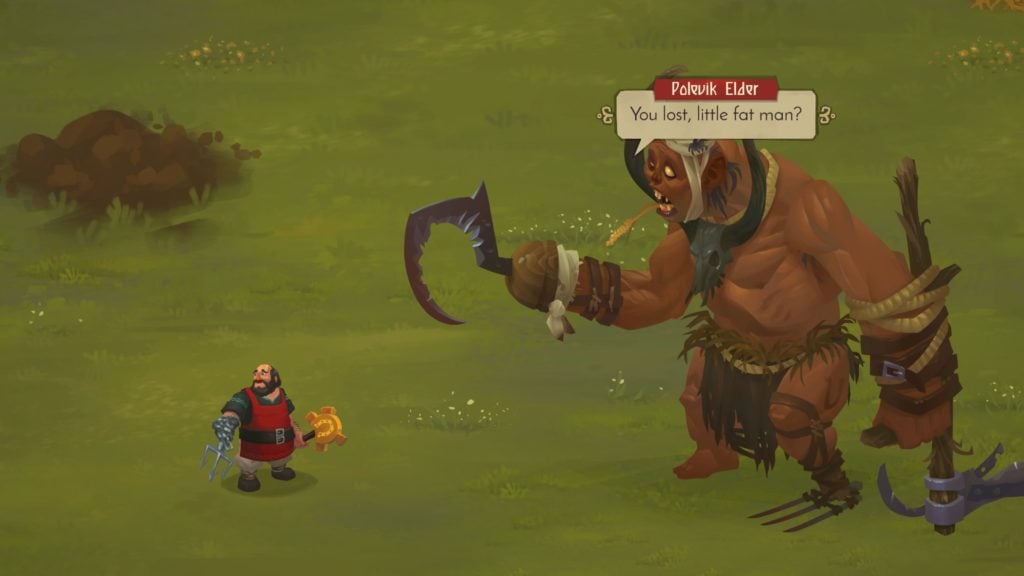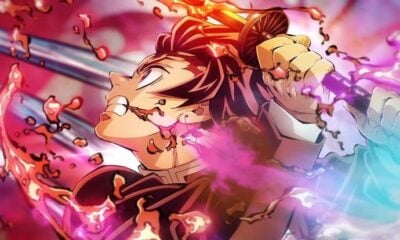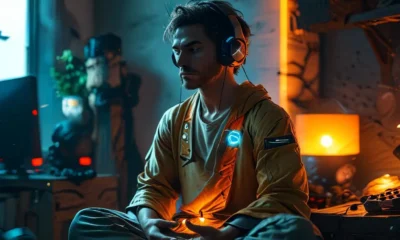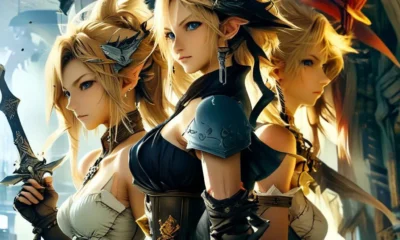Features
“A Different Spin on What Roleplaying Means” – An Interview with the Creator of Fairy Tale RPG ‘Yaga’
There’s more to fairy tales than the Brothers Grimm. Stories like Cinderella or Rapunzel may be familiar subject matter in film and games, but they’re only part of the story. There’s entire traditions of folklore that don’t see the same amount of representation in popular media – take the Slavic story of the magical Baba Yaga or the fearsome One-Eyed Likho, for instance. These are traditional stories of Eastern European culture, and Yaga, an upcoming roguelike RPG, is aiming to finally give them their long-overdue representation in games.
“Yaga tells the story of Ivan, a one-handed blacksmith followed by bad luck,” says Catalin Zima-Zegreanu, the game’s creator and designer. “Being sent on impossible quests by a Tzar who wants him gone, Ivan must find a way to please his ruler, and maybe get rid of Bad Luck through his journey.” Set in a world of Slavic history and culture, populated by colorful creatures and characters from ancient stories, and presented with Russian storybook-style visuals and a soundtrack that mixes folkloric melodies with a modern hip hop style, Yaga is all about capturing the cultural heritage of Eastern Europe.
“I really believe that the ability to tell stories and the stories we tell is one of the key ingredients of what makes humans… human”
From the beginning, narrative has been a deeply important aspect of Yaga. Zima-Zegreanu himself testifies to this with examples from his own life. While he began his career as a programmer, he confesses that he has always had “a soft side” for creative writing, including poetry and fantasy pen-and-paper games with friends. “I really believe that the ability to tell stories and the stories we tell is one of the key ingredients of what makes humans… human, which makes storytelling one of the things I’m really passionate about.”
To that end, the development team dived deep into mythological literature, poring over different renditions of traditional tales to present the most accurate versions of them in Yaga. However, the scope of this goal evolved during development. “When we set out as a team and discussed what game we wanted to make, we had several ideas on the table,” Zima-Zegreanu says. “One of them was making a roguelike with a focus on Eastern European mythology, which was underrepresented at that time in games. But going through all the stories and folktales we used as research, we realized that simply taking the monsters from there was not enough. Reading books after books about Slavic traditions and collections of folktales, we realized the complete picture of the things we wanted to highlight: the life and beliefs of Slavic peasants, the superstitions and magic they believed in and the art and motifs that are part of that culture.”
This ambitious new focus drastically altered the game’s direction. While Yaga had initially been like a typical roguelike with a greater emphasis on gameplay over story, it eventually evolved into a much more narrative-focused experience. Rather than the typical roguelike progression of loot and upgrades with a very light narrative, “The focus of the game became the characters and the interactions between the hero and the people he meets.”
Great care went into bringing these characters to life while respecting their traditional source material. “One of the most exciting things was getting all the reference material and turning it into actual quests inside our game. We would take a character from a short story and see how we can create a small encounter around them. Then we gave our artists freedom in visualizing that character and adding lots of little personal details in their looks and animations.”
Eastern European legends bear plenty of similarity to other folk traditions on the surface. After all, they feature just as much magic and otherworldly creatures as you’d expect from many other world traditions. However, Zima-Zegreanu sees something unique in Slavic folktales: their “darkly funny” mood and tone. With Yaga, he set out to present this through its writing.

“They are not overly serious like many mythological tales, and neither are they funny for the sake of being funny. But they often tackle sad subjects, so the humor usually comes from the character trying to make the most out of their hard situations and trying to find a little bit of humor in their grim and troublesome life. When talking about past hardships, people often add bits of commentary to highlight ironies, or use self-deprecating humor to lighten up the judgement that you could otherwise pass on their past decisions. This is something that we wanted to use in our writing as well. The things happening to poor peasants in the past were often sad or tragic, so the question we kept asking ourselves was: ‘How would a storyteller lighten up the mood when talking about this?'”
“From the start, we wanted to have a different spin on what roleplaying means in the game”
The structure of Yaga parallels the oral traditions it’s based on. It will always tell the same overarching story, but just like how fairy tales can change with each telling, no two playthroughs will yield the exact same narrative. Zima-Zegreanu and his team “decided that even if the main story beats and challenges would be the same, the experience of going through them would be different, as if the same story is told by a different narrator.”
This historic and cultural setting might be unfamiliar for some, but the gameplay underneath it should feel familiar. Yaga boasts of all the hallmarks of the RPG genre, including monsters to face, weapons to craft, experience to gain, and plentiful helpings of side quests. It also takes inspiration from indie classics like Bastion, Binding of Isaac, and Guacamelee!, the last of which was particularly inspiring due to how it balanced cultural backgrounds with modern game design. However, Yaga sets its gameplay apart with one major trait: its emphasis on player freedom.
“From the start, we wanted to have a different spin on what roleplaying means in the game,” Zima-Zegreanu explains. “The choices you make during dialogues have a strong influence over how your character progresses. An aggressive character will learn how to fight better, a selfish character will learn how to make more money, and so on. And all the little choices throughout the game come together in the end, where you can discover several different endings.”
Fittingly enough, Yaga gives players plenty of liberty in how their character can progress through the story. Rather than forcing players to choose between strict “good” and “evil” paths, Zima-Zegreanu’s team placed a greater emphasis on players’ distinct personalities, which will lead them down four different paths: righteous, selfish, aggressive, or foolish. For instance, “A character who is always aggressive will get different upgrade options than one who is foolish, or righteous.” It is the development team’s hope that “each version of the hero at the end of the game will feel personal to the player that made those choices.”
Such a freeform structure is a natural fit for fairy tales, but video games are a different issue entirely. “The biggest challenge we faced was finding the right balance between allowing player choice and following the story structure of a folktale,” Zima-Zegreanu explains. “In a folktale, the main character is rarely a villain, and some structural elements, like the hero’s refusal or the lessons learned by the character, are not easily translatable into an interactive medium.”
It took time, but at length a resolution was found. “The middle ground we discovered was not focusing on what the player character does, but also on why and how they do it. This allows two players to go through the same story beats, but their character arcs feel different due to their playstyle, choices, and motivation they imbue their characters with.”
Choice is an extremely important element of Yaga, and for some players, it may be tempting to play it safe and make the easiest choices to ensure a positive ending. Yet players are given freedom to explore its deep cultural narrative, to learn more about a different type of fairy tale, and to truly impact the way their unique narrative plays out. Zima-Zegreanu encourages players to take advantage of all of this: “Don’t be afraid of Bad Luck! Even though the character’s Bad Luck increases if you make dialogue choices that are different than your current personality, don’t be afraid to try a different option if you find it interesting.” He ends with one final warning: “Also…don’t be foolish!”

-

 Features4 weeks ago
Features4 weeks agoDon’t Watch These 5 Fantasy Anime… Unless You Want to Be Obsessed
-

 Culture3 weeks ago
Culture3 weeks agoMultiplayer Online Gaming Communities Connect Players Across International Borders
-

 Features3 weeks ago
Features3 weeks ago“Even if it’s used a little, it’s fine”: Demon Slayer Star Shrugs Off AI Threat
-

 Features2 weeks ago
Features2 weeks agoBest Cross-Platform Games for PC, PS5, Xbox, and Switch
-

 Game Reviews4 weeks ago
Game Reviews4 weeks agoHow Overcooked! 2 Made Ruining Friendships Fun
-

 Features2 weeks ago
Features2 weeks agoThe End Is Near! Demon Slayer’s Final Arc Trailer Hints at a Battle of Legends
-

 Features3 weeks ago
Features3 weeks ago8 Video Games That Gradually Get Harder
-

 Game Reviews4 weeks ago
Game Reviews4 weeks agoHow Persona 5 Royal Critiques the Cult of Success
-

 Features2 weeks ago
Features2 weeks agoDon’t Miss This: Tokyo Revengers’ ‘Three Titans’ Arc Is What Fans Have Waited For!
-

 Uncategorized3 weeks ago
Uncategorized3 weeks agoSleep Meditation Music: The Key to Unwinding
-

 Guides2 weeks ago
Guides2 weeks agoHow to buy games on Steam without a credit card
-

 Game Reviews2 weeks ago
Game Reviews2 weeks agoFinal Fantasy VII Rebirth Review: A Worthy Successor?






















